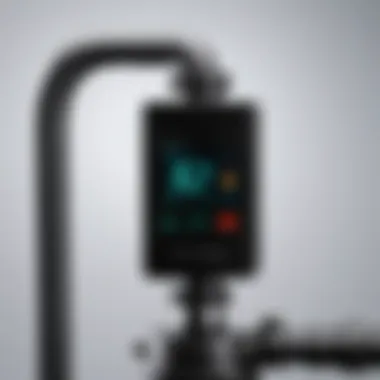Electric Water Pumps for 19-Liter Bottles: Guide


Intro
When it comes to daily hydration, convenience plays a key role. For many households, particularly those with children or busy professionals, electric water pumps for 19-liter bottles have become something of a game changer. These devices relieve us from the cumbersome process of lifting and pouring heavy bottles, simplifying our hydration routines significantly.
A pivotal point about these pumps is their efficiency. Not only do they help to remove the physical strain associated with handling large water containers, but they also bring a sense of ease to filling glasses, jugs, or even cooking pots. In a world where time is gold, having quick access to fresh water can make all the difference.
However, choosing the right pump is not as straightforward as it might seem. With a plethora of options available on the market, understanding what makes a good purchase means diving into the nitty-gritty details of features, benefits, and usage tips.
As families become increasingly aware of health and practicality, options like these pumps emerge as viable alternatives. They aren't only about quenching thirst, but they also represent a shift towards more strategic and efficient living. Just like finding a needle in a haystack, identifying the right electric water pump involves sorting through deals, discounts, and unique products that complement one’s lifestyle.
Throughout this guide, we will explore various facets of electric water pumps specifically designed for 19-liter bottles – from current market trends to user-centric advice, ensuring you leave well-equipped to make smart choices for hydration needs.
Now, let's dive into the latest offers and discounts you can utilize to snag a great deal on these essential hydration tools.
Актуальные акции и скидки
Обзор текущих предложений
As of now, some retailers have rolled out discounts and promotional offers specifically tailored for electric water pumps. Shoppers may find significant savings during seasonal sales, especially around holidays or back-to-school periods. This could be the perfect opportunity to grab a reliable pump without breaking the bank.
- Retailer A: Currently offering 15% off on select brands of electric water pumps. This deal will last until the end of the month.
- Retailer B: Features a buy-one-get-one option for promotional packages, beneficial for families or larger gatherings.
Специальные предложения от популярных брендов
In addition to the aforementioned sales, several renowned brands are keeping their pricing competitive.
- Brand X: Known for quality, is offering a limited-time promotion that includes free shipping with purchases over a certain amount.
- Brand Y: Has introduced a loyalty program where consumers can earn points on every purchase, redeemable against future buys of their pump models.
These offers create avenues not just for savings but also ensure you are investing in high-quality hydration solutions. With these deals, families can enhance their kitchens and simplify daily routines, while budget-conscious individuals can make the best of their resources.
Next, we will explore some recommended products that stand out in the market, especially those that offer the best value for money.
Understanding Electric Water Pumps
Electric water pumps are increasingly becoming a staple in many households, especially those relying on 19-liter water bottles. Understanding this little powerhouse is crucial for anyone considering its use. Not only does it simplify hydration, it also reshapes how we manage our water consumption at home. In the urban hustle and bustle, where convenience often takes precedence, electric water pumps can save time and effort without compromising on functionality. This section aims to dissect what these pumps are, how they operate, and how they stand up against their manual counterparts.
Definition and Purpose
An electric water pump, at its core, is a device designed to dispense water from large bottles via an integrated electrical system. The primary purpose of these pumps is to provide a hassle-free solution for accessing clean drinking water without the need for lifting or manual pouring. Simply put, they remove the physical strain of manually flipping a hefty bottle and enable a more efficient flow of water to your drinking glass. For busy families or anyone with limited mobility, this can be a game changer, making hydration not just easier but also more appealing.
Mechanism of Operation
Diving into the nitty-gritty, electric water pumps generally operate on a rather straightforward mechanism. Most models come equipped with a plastic tube that extends down into the water bottle, and a small pump motor that creates suction. When you activate the pump, usually through a button or sensor, the motor initiates, drawing water up through the tube and out the spout.
The pump's design may vary, but many feature rechargeable batteries or wall adapters, offering both convenience and portability. This alleviates the worry of always being near an outlet.
One can imagine the sound of a gentle hum as it works, often seamlessly blending into the background of daily life. This mechanical marvel is designed to deliver water consistently while ensuring minimal waste.
Comparison to Manual Pumps
While electric pumps boast convenience, they stand in stark contrast to manual pumps, which require physical effort to operate. Manual pumps pushes water upwards through a pumping action, often involving a lever or handle, potentially leading to fatigue if used frequently. In contrast, electric pumps allow users to fill their glasses at the touch of a button.
In terms of efficiency, electric pumps generally dispense water faster than manual versions. Moreover, the likelihood of spills is considerably reduced with electric styles, making them a safer option, particularly in households with children. However, some may argue that manual pumps can be more reliable in situations without electricity—an interesting point to consider when weighing your options.
The choice between electric and manual boils down to personal preference and lifestyle requirements.
In essence, understanding electric water pumps provides a foundation necessary to navigate the available options effectively. It equips buyers with the information needed to make choices that align with their hydration needs and lifestyle habits.
Benefits of Using Electric Pumps
Electric water pumps represent a significant upgrade in how we handle hydration solutions, especially when considering the needs of families, economically conscious individuals, and those with busy lifestyles. The integration of electric pumps into daily routines can transform the simplest task of pouring water into a much more pleasant experience. Let’s dive deeper into the concrete advantages these devices bring to the table.


Convenience and Ease of Use
When it comes to convenience, electric pumps are like a breath of fresh air. Picture this: You’re knee-deep in work or looking after kids, and all you need is a quick sip of water. With an electric water pump, you just press a button, and voilà! It dispenses the water you need without the hassle of lifting the heavy bottle or maneuvering a manual pump. This ease of use is especially beneficial for the elderly or individuals with limited strength.
- No heavy lifting: Say goodbye to the back-breaking effort of lifting bulky water bottles.
- User-friendly design: Most electric pumps come with straightforward controls, making them accessible for all ages.
- Compact and portable options: They can easily be transported, ensuring hydration is always within reach, whether at home or on a picnic.
Speed of Operation
Electric pumps don’t just make things easier; they speed up the entire process. When you need a quick drink, the last thing you want is to fumble around with a manual pump. Electric pumps operate swiftly—most dispense a full cup of water in mere seconds. For larger gatherings or during peak times when everyone is quenching their thirst, this efficiency cannot be overstated. It streamlines the whole drinking experience, ensuring that the focus stays on enjoying time with family and friends, rather than wrestling with a water source.
- Instant gratification: Press the button, and your water is ready almoast instantly.
- Great for social settings: Nobody likes waiting in line for water. With electric pumps, you free up time for conversations outside the kitchen.
- Faster refills: In settings where hydration is key, like during workouts or hot weather, quick dispensing keeps everyone on track.
Consistency in Dispensing
Consistency is key, especially in busy households or for health-focused individuals who need to track their water intake. Electric pumps offer a reliable flow of water, ensuring that each pour is uniform and predictable. This reliability can help those who are trying to maintain a certain level of hydration throughout the day, making it easy to establish good habits.
- Stable flow rates: Electric pumps usually offer a steady dispense rate, which manual pumps often lack, leading to variations in portion sizes.
- Accurate measurements: Some advanced electric models provide options for measured servings, which can be beneficial for families with specific dietary needs.
- Reduced spillage: Since the dispensing mechanism is controlled, it reduces the risk of messy spills.
"Switching to an electric water pump changed my daily routine; pouring water is now the easiest part of my day!" - Sarah, a satisfied user
In summary, the benefits of using electric pumps cannot be emphasized enough. They provide convenience, speed, and consistency—all vital elements for daily hydration in modern living. As we explore the remaining sections, it will become clear how these aspects enhance not just the act of drinking water but also overall lifestyle efficiency.
Key Features to Consider
When choosing an electric water pump for your 19-liter bottles, understanding the features is key. It's not just about choosing a pump; it’s about selecting a tool that fits your lifestyle, your needs, and your environment. Here’s a closer look at three main elements to consider: power source and efficiency, materials and durability, and pump design and ergonomics.
Power Source and Efficiency
The power source of an electric water pump is one of the most crucial factors to keep in mind. Pumps generally operate on batteries, AC mains, or USB charging systems. A battery-powered pump, for instance, offers flexibility, letting you use it wherever you want, but you'll eventually need to manage battery life. On the other hand, a pump plugged into the wall might limit your movement but typically provides consistent performance without the worry of running out mid-pour.
Efficiency often accompanies power source choices. An energy-efficient pump can save not just electricity but also money. Look for pumps that promise low energy consumption while still delivering strong performance. For a regular household, picking an efficient variant can reflect positively on both cost and environmental impact.
Important Note: Always consider the pump's power consumption in relation to your typical water usage. This assessment can guide you better in selecting the pump that fits within your budget over time.
Materials and Durability
The materials used in the construction of the pump can significantly impact its lifespan and reliability. Most electric water pumps are made from plastics or stainless steel. Plastics are lightweight and usually less expensive, but they may degrade faster, especially if exposed to heat or harsh cleaning chemicals. Stainless steel, however, can offer a longer lifespan and may resist corrosion better.
Furthermore, think about how often your pump will be in use. If you have a busy household or regularly host events, durability becomes paramount. An electric pump that can withstand a bit of rough treatment is worth the investment. Check reviews and user feedback to see how specific models hold up over time.
- Common materials include:
- Plastic (sometimes BPA-free)
- Stainless steel
- Silicone seals
Pump Design and Ergonomics
Pump design and ergonomics are more than just about aesthetics. A well-designed pump can enhance your user experience significantly. Look for features like a comfortable grip for easy handling and a drip-free nozzle that simplifies pouring. A design that allows you to easily see how much water you have left in the bottle can also make hydration management a breeze.
Pay attention to the overall size and weight as well. If you have children who might use the pump, lightweight and compact models are easier for them to handle safely. A setup that minimizes strain during operation will encourage regular hydration habits for everyone in the family.
In summary, when choosing an electric water pump for 19-liter bottles, consider the power source and efficiency, materials and durability, as well as pump design and ergonomics. Each of these elements plays a critical role in ensuring that the pump not only serves its purpose but also stands the test of time in the daily hustle of your household.
Installation and Usage
When it comes to electric water pumps for 19-liter bottles, the proper installation and usage can make or break your experience. Understanding how to set it up correctly not only ensures it works effectively but also prolongs the appliance's lifespan. It’s crucial for anyone looking to adopt this technology for easier hydration to know the ins and outs of installing the pump and using it safely. Let’s dive into the the essentials that every user should consider.
Step-by-Step Installation Guide
- Gather Your Tools and Components
Ensure you have everything laid out before you start. You'll need the electric pump, a compatible bottle, and possibly some adhesive strips for stability. - Attach the Pump to the Bottle
Position the electric pump directly on top of the 19-liter bottle. It should fit snugly; some pumps even have a base that helps secure it in place. - Connect Power Supply
Plug in the pump to the nearest socket. Check your electrical ratings before you proceed to avoid any mishaps. Ideally, the power source should not be overloaded. - Test the Setup
Once everything is in place, press the power button. Let the pump run for a moment to check for leaks or any unusual noises. If something seems off, turn it off immediately and reassess your connections. - Positioning
Make sure the pump is on a stable surface. A shaky setup can not only be messy when dispensing water but may also lead to damage over time.
Operating the Electric Pump


Operating your electric pump is usually straightforward, but knowing a few practical tips can enhance your experience.
- Power On
After installation, simply hit the power button. Most pumps have a clear indicator light that tells you if it’s on. - Water Dispensing
Hold your container under the spout and either press a button or, in some models, the dispenser will start as soon as you place the container underneath. Make sure you’ve got it aligned right, or you could end up with a splash. - Shut Off
Once your container is full, the pump may automatically stop, or you may need to turn it off manually. Be mindful of this to avoid overflowing.
Safety Precautions
While using an electric water pump, safety should be top of mind. Here are a few precautions to consider:
- Avoid Overloading Circuits
Plug the pump into a dedicated power outlet. Sharing with other devices may trip a breaker. - Regular Inspections
Check for frayed cords or any signs of wear. If you see anything unusual, replace the pump. - Keep Away from Water
Although the pump dispenses water, don’t let excess water accumulate near the electrical parts. Moisture and electricity don’t mix well. - Follow Manufacturer Instructions
Each electric pump will have its own nuances. Always follow the instructions specific to your model for safe handling.
Remember: Proper installation and aware usage go a long way in making the most out of your electric water pump. Not only does it enhance your convenience, but it also keeps the pump in tip-top shape for longer. Maintain it right, and it will serve you well!
Understanding how to install it, operate it, and the safety aspects involved helps create a seamless hydration experience at home or in the office. As you becoming more familar with your electric pump, your hydration routine will become just that much simpler.
Maintenance and Care
Taking care of your electric water pump is not just a good idea, it's an essential part of ensuring its longevity and efficiency. When you invest in a water pump, especially for 19-liter bottles, understanding maintenance practices will save you time, money, and frustration down the line. While these pumps are designed to last, neglect can lead to a decrease in performance or even costly replacements. So, let’s unpack the who, what, where, and how of keeping your pump in top shape.
Routine Cleaning Practices
Cleaning your electric water pump is crucial to prevent contamination and bacterial growth. Here's how to do it:
- Disassemble the Pump: Start by unplugging the device and removing any components as per the manufacturer's instructions. It's wise to consult the user manual before this step to avoid any mishaps.
- Wash with Mild Soap: Use a solution of warm water and mild dish soap to clean the exterior and removable parts. A soft cloth or sponge works wonders here. Avoid harsh chemicals that may tarnish or damage the materials.
- Rinse Thoroughly: After scrubbing, rinse your pump parts under running water to remove any soap residue. Leftover soap can affect the taste of your water.
- Dry Completely: Allow all parts to dry fully before reassembling. This minimizes moisture, which can promote mold or mildew.
"A clean pump is a happy pump, and a happy pump means clean water!"
Troubleshooting Common Issues
Even the best pumps can hit a snag once in a while. Here are simple steps to troubleshoot frequent problems:
- No Power: Check if it’s plugged in or if there’s an issue with the power source. Sometimes it’s just a blown fuse or a loose connection.
- Weak Water Flow: This could stem from blockages in the hose or pump mechanism. Check for any obstructions and clear them out.
- Strange Noises: If your pump is making odd sounds, it might be an indication of internal wear or debris caught inside. Turn it off immediately and inspect.
- Overheating: If the pump gets too hot, it might need a break. Turn it off for a while, and check for any dust or blockage in the ventilation areas.
Extending the Pump's Lifespan
Here are several tips to get the most miles out of your electric water pump:
- Regular Maintenance: Just like a car, regular check-ups can assist in spotting potential issues before they become major repairs. Aim to clean it every few weeks depending on usage.
- Safe Storage: Store your pump in a cool, dry area when not in use. Extremes in temperature and humidity can damage electronic components and seals.
- Avoiding Exposure to Elements: If your pump is meant for indoor use, keep it away from outdoor weather conditions like rain or snow which can cause corrosion.
- Follow Manufacturer's Instructions: Every pump is unique, so it’s imperative to know the specific requirements outlined by the manufacturer. Ignoring these can void warranties or risk damage.
By incorporating these maintenance and care practices, you can not only enhance the user experience but also ensure that your electric water pump serves you well for years to come. Effective management of your devices reflects in household efficiency and overall satisfaction.
Market Overview
Understanding the market landscape for electric water pumps designed for 19-liter bottles is essential for making an informed purchase. The rising demand for convenient hydration solutions drives various brands to develop innovative and reliable models that cater to different consumer needs. This section sheds light on the key players, pricing strategies, and user experiences that shape the market.
Popular Brands and Models
When it comes to choosing the right electric water pump, several brands stand out. Some notable names include:
- AquaTop: Known for their sleek designs and durability, AquaTop pumps are a favorite among families looking for efficient hydration.
- WaterCoolerDirect: Offering a range of models, they impress consumers with their intuitive operation and good performance.
- Ozark Trail: This brand captures attention with budget-friendly options that don’t skimp on quality.
It’s wise for consumers to read specifics about popular models, such as each model's flow rate, battery life, and user convenience features. For instance, some models come with rechargeable batteries, which can appeal to eco-conscious consumers.
Price Ranges and Features
Pricing for electric water pumps can vary significantly, typically falling within the range of $20 to $70. Here’s a breakdown:
- Basic Models: Usually priced around $20-$30, these often have simple features, sufficient for occasional use.
- Mid-Range Options: Priced between $30-$50, these models generally offer better durability, additional features, like adjustable flow rates, and often come with customer support.
- Premium Models: At the higher end, around $50-$70, consumers can expect advanced features, greater efficiency, and higher quality materials.
When considering features, buyers should focus on flow rate, compatibility with bottle types, and ease of cleaning. Investing slightly more in a pump may yield longer-term savings and satisfaction.
User Reviews and Feedback


Customer reviews play a crucial role in shaping purchasing decisions. They provide real-world insights that specs and marketing materials can’t always convey. On platforms like Reddit and Facebook, users often share their experiences, highlighting aspects such as:
- Ease of Use: Many find that some models can be operated with just one button, making it convenient for all family members.
- Durability: Positive feedback often targets the longevity of pumps, especially those made from high-quality materials.
- Customer Support: Brands that offer responsive and effective customer service tend to have more satisfied users.
"I used to dread lifting those heavy bottles until I got an Ozark Trail pump—what a game-changer!" - A satisfied user
In summary, a careful look at the market overview helps consumers identify not just what they want but also what they truly need in an electric water pump for 19-liter bottles. Understanding popular brands, price ranges, and authentic user feedback can lead to a savvy purchase, ensuring efficient hydration solutions for every household.
Sustainability and Environmental Considerations
In recent years, the conversation around sustainability has grown louder, resonating especially in households seeking ways to lessen their environmental footprint. Choosing an electric water pump for 19-liter bottles isn't just about convenience; it also plays a role in promoting sustainability. This section dives into how electric pumps align with eco-friendly practices, particularly by focusing on aspects such as reducing plastic waste and enhancing energy efficiency.
Reducing Plastic Waste
Switching to an electric water pump significantly lowers the reliance on single-use plastic bottles. When using traditional methods of water dispensing, users often find themselves buying smaller single-use containers, which contribute to plastic pollution.
- Less Disposable Plastic: The electric water pump encourages the use of bulk water systems. Instead of purchasing numerous 500 ml or 1-liter plastic bottles, consumers can refill reusable containers or drink straight from the 19-liter bottle.
- Long-Term Savings: Not only is it better for the environment, but it also benefits the wallet in the long run. While the upfront cost of a pump might seem steep, the savings from reduced plastic purchases add up over time.
By simply switching to a 19-liter bottle and an electric pump, one can significantly reduce the plastic pollution generated by household consumption.
- Support Local Companies: Many brands manufacture electric pumps from recyclable materials. By choosing to support these companies, consumers indirectly encourage environmentally responsible practices in manufacturing.
Energy Efficiency of Electric Pumps
The energy consumption of electric water pumps can be a concern for eco-conscious users. However, many models are designed with energy efficiency in mind, which optimizes performance without excessive energy costs.
- Smart Technology: Some electric pumps come equipped with sensors or timers that curtail unnecessary power use. This technology ensures the pump operates only when needed, further reducing its carbon footprint.
- Comparative Efficiency: Compared to manual methods that could use more energy indirectly (like physical exertion or even potential spills leading to wasted water), electric pumps show a more favorable energy efficiency metric.
- Renewable Energy Sources: Users can power their electric pumps with solar energy or other renewable sources, profoundly minimizing their environmental impact. Connecting these pumps to solar panels turns a simple household convenience into a sustainable solution.
In summary, incorporating electric water pumps in daily routines represents a meaningful step towards environmental stewardship. These considerations reflect an ongoing commitment to sustainability while making day-to-day life simpler and more efficient.
Economic Impact on Household Expenses
Understanding the economic impact of using electric water pumps for 19-liter bottles is crucial, especially for young professionals, families with children, and cost-conscious individuals. These pumps do not merely serve as a convenience; they can substantially influence overall household expenses and efficiency in water usage. By examining cost considerations and budgeting, one can grasp how these devices fit into a broader financial strategy.
Cost-Benefit Analysis
When considering an electric water pump, conducting a cost-benefit analysis is a must. At first glance, the investment might seem high, especially compared to traditional manual pumps. However, one should consider the following points:
- Initial Costs vs. Long-Term Savings: While a good electric pump can range anywhere from $30 to $100, it could save you significant time and effort. No more struggling to pump water manually can lead to increased productivity in daily chores. Spending a few extra dollars on a quality pump that lasts several years often outweighs cheaper alternatives that need constant replacement.
- Energy Efficiency: Most electric pumps are designed to use minimal energy. While they do incur some electricity costs, these can be far less than the costs associated with bottled water sourced from stores, which often doubles up on transportation costs too.
- Usage Frequency: If you’re a regular user of 19-liter bottles, the cost of frequent manual labor can add up. Electric pumps simplify this task, potentially translating to energy savings if you factor in the time saved.
"Investing in a good quality electric water pump is like putting money in a piggy bank. Over time, you'll find that initial cost comes back to you in spades."
Budgeting for Household Water Needs
Budgeting smartly is essential for every household, and incorporating an electric water pump into your budgeting plan can yield several benefits. Here’s how you might outline your budget effectively to accommodate the use of an electric pump:
- Estimate Monthly Water Usage: Understand how much water you and your family consume monthly. By analyzing this, you can predict the number of bottles needed and the accompanying costs.
- Allocate a Specific Amount for Water Bottles: Once you’ve categorized your average consumption, allocate a particular budget for purchasing 19-liter bottles. By doing this consistently, you can also track your spending and avoid surprises at the end of each month.
- Consider Maintenance Costs: Allocate a small amount for maintenance and repairs of your electric pump. Setting aside a budget can be beneficial in the long run, as it helps keep the pump in good working condition, elongating its lifespan.
- Emergency Fund for Unexpected Costs: Sometimes, things go awry. Having a safety net for unforeseen repairs or replacements can relieve much of the stress associated with budgeting.
This approach ensures you’re not just throwing money around but investing wisely in a system that will serve you and your family well in the long haul. Keeping things organized helps not just in managing costs but also in making the best decision on what pump to buy based on your unique usage and budgeting.
By implementing these strategies and considering the economic impact, households can move towards a more efficient way of managing water needs. With the right pump in place, families can enjoy the ease of hydration while keeping an eye on their financial well-being.
Epilogue
Understanding the nuances of electric water pumps for 19-liter bottles is essential, not just for convenience but also for making educated purchasing choices. These pumps offer a practical solution for households aiming to streamline hydration without the fuss of manual pumping. With the plethora of features and varieties available in today’s market, buyers can find models that not only fit their specific needs but also enhance efficiency.
Summary of Key Points
- Purpose and Functionality: Electric water pumps are designed to simplify the task of dispensing water from large bottles, providing ease for everyday use.
- Benefits: They allow for quicker dispensing, consistent flow rates, and a significant reduction in physical effort compared to manual counterparts, ultimately supporting healthier hydration habits.
- Key Features: Factors such as power source, durability of materials, and ergonomic design greatly impact the user experience and lifetime of the product.
- Market Insights: The variety in brands and models ensures that users can choose based on price, features, and user feedback, catering to different budgets and preferences.
- Sustainability Considerations: Using electric pumps can contribute to environmental practices by reducing single-use plastic consumption, while also allowing for better management of water usage.
Final Thoughts on Electric Water Pumps
In the end, investing in an electric water pump is about embracing convenience while promoting a healthier lifestyle. For families, these devices can serve as a game changer, making hydration easy for both adults and children alike. Furthermore, being aware of the economic implications and potential energy savings can lead to more strategic budgeting for household hydration needs.
Choosing the right electric pump doesn't just fill a bottle; it fills the gap between convenience and sustainability, allowing families to drink smartly while caring for their health and the environment.
Electric water pumps cater to modern-day challenges, making them a necessary tool for those committed to practical living. Ultimately, when considering your options, weigh the benefits and features that best align with your needs to ensure an informed decision that best serves your household.



